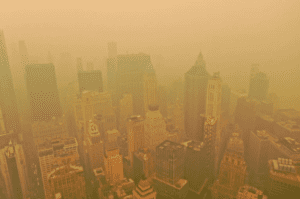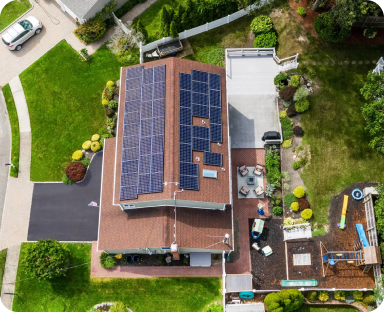During the months of June and July, smoke from Canada’s intense wildfires drifted southward into the U.S. causing unexpected and concerning environmental challenges. The smoke generated hazy, orange visibility and a surge in air pollution levels across multiple U.S. states. The influx of smoke particles and pollutants not only led to a decline in air quality across affected U.S. states, but also had a direct impact on solar irradiance—a crucial factor in solar energy production. Following June and July’s low production from Wildfires, our region experienced an increase in inclement weather days in August and September, resulting in 15% lower irradiance in 2023 than previous years during the same season.
Solar irradiance, the amount of solar radiation received by the Earth’s surface, was significantly affected as sunlight struggled to penetrate the dense smog and cloud cover. As a result, solar panels experienced a notable reduction in efficiency and energy output. Bloomberg reported a staggering 56% decrease in electricity generation from New England solar farms during peak times compared to the previous week due to the smoke pollution. In New York State, which was one of the most affected areas by the Canada wildfire smoke, solar energy production declined by 1,466 megawatts (MW) over a span of two days, from June 6th to June 7th according to a tweet from New York ISO (1 MW of electricity can power roughly 750 homes instantaneously). This substantial decrease in solar energy production shows the direct correlation between environmental events and solar systems.

New York City covered in smoke from Canadian wildfires (Image: Patrick Reilly / New York Post / Anadolu Agency via Getty Images)
How will this affect my system?
EmPower Solar, recognizing the substantial impact on solar energy production, conducted an audit of clients’ solar systems. A comparison was created between solar energy production for the months of June and July this year and the corresponding period in 2022. As a result of this assessment, clients can expect to see an approximate 10 – 15% reduction in their solar system’s energy production for the month of June, followed by a 5 – 10% reduction for July when compared to the previous year.
The confusing part is, you may not even notice that your system is down 10% until later this fall. Normally, this time if year is prime for building up energy credits with summer sun.
This summer’s energy production decline will also affect your solar system’s net metering and your credits going into the fall months. Net metering, which involves generating energy credits during peak periods such as the summertime for later use during high energy demand months like winter to reduce utility bills, will be impacted by the reduction in solar energy output. If you want to learn more about net metering, check out this blog.
How can I reduce the impact of the wildfires on my energy production?
Clients can take steps to reduce the impact of the decreased solar energy production by focusing on their consumption. Implementing energy-efficient practices and optimizing energy consumption patterns can help offset the reduction in solar energy generation. Some examples of these practices include minimizing electricity usage by air conditioning on extreme heat days, using energy-efficient appliances, having proper house insulation, and charging your EV at work if possible.
Stop overpaying for electric. Go solar with $0 down.

Stop overpaying for electric. Go solar with $0 down.
About the Author
EmPower Solar develops, engineers, installs, and services solar and battery systems for residential and commercial clients. Since 2003, EmPower Solar has empowered thousands of New York homeowners and businesses with 47 megawatts of distributed solar. Its vision is to create a new energy paradigm powered by clean, renewable energy for a more prosperous, healthy, and civil world. The company culture is defined by the EmPowering Way, which results in consistent 5-star customer service reviews. For more information visit empower-solar.com.